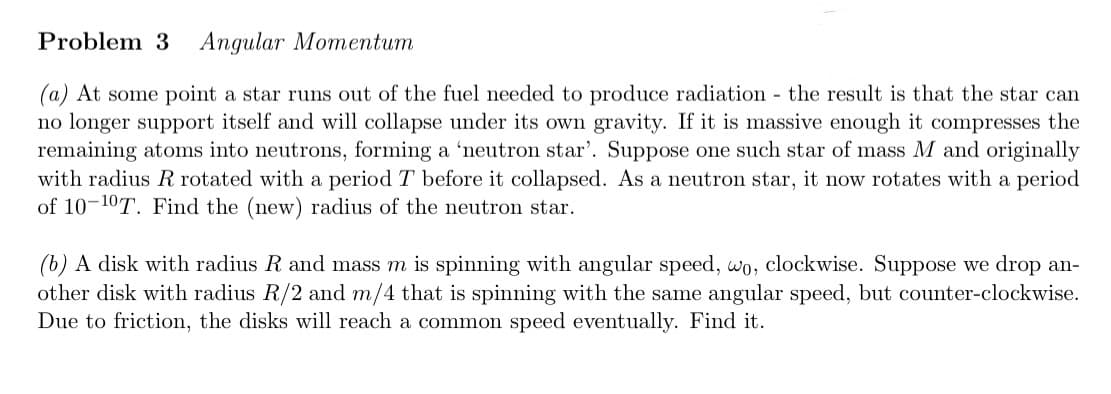Problem 3 Angular Momentum (a) At some point a star runs out of the fuel needed to produce radiation - the result is that the star car no longer support itself and will collapse under its own gravity. If it is massive enough it compresses the remaining atoms into neutrons, forming a 'neutron star'. Suppose one such star of mass M and originally with radius R rotated with a period T before it collapsed. As a neutron star, it now rotates with a period of 10-10T. Find the (new) radius of the neutron star. (b) A disk with radius R and mass m is spinning with angular speed, wo, clockwise. Suppose we drop an other disk with radius R/2 and m/4 that is spinning with the same angular speed, but counter-clockwise
Problem 3 Angular Momentum (a) At some point a star runs out of the fuel needed to produce radiation - the result is that the star car no longer support itself and will collapse under its own gravity. If it is massive enough it compresses the remaining atoms into neutrons, forming a 'neutron star'. Suppose one such star of mass M and originally with radius R rotated with a period T before it collapsed. As a neutron star, it now rotates with a period of 10-10T. Find the (new) radius of the neutron star. (b) A disk with radius R and mass m is spinning with angular speed, wo, clockwise. Suppose we drop an other disk with radius R/2 and m/4 that is spinning with the same angular speed, but counter-clockwise
Related questions
Question

Transcribed Image Text:Problem 3 Angular Momentum
(a) At some point a star runs out of the fuel needed to produce radiation - the result is that the star can
no longer support itself and will collapse under its own gravity. If it is massive enough it compresses the
remaining atoms into neutrons, forming a 'neutron star'. Suppose one such star of mass M and originally
with radius R rotated with a period T before it collapsed. As a neutron star, it now rotates with a period
of 10-10T. Find the (new) radius of the neutron star.
(b) A disk with radius R and mass m is spinning with angular speed, wo, clockwise. Suppose we drop an-
other disk with radius R/2 and m/4 that is spinning with the same angular speed, but counter-clockwise.
Due to friction, the disks will reach a common speed eventually. Find it.
Expert Solution
This question has been solved!
Explore an expertly crafted, step-by-step solution for a thorough understanding of key concepts.
Step by step
Solved in 3 steps
